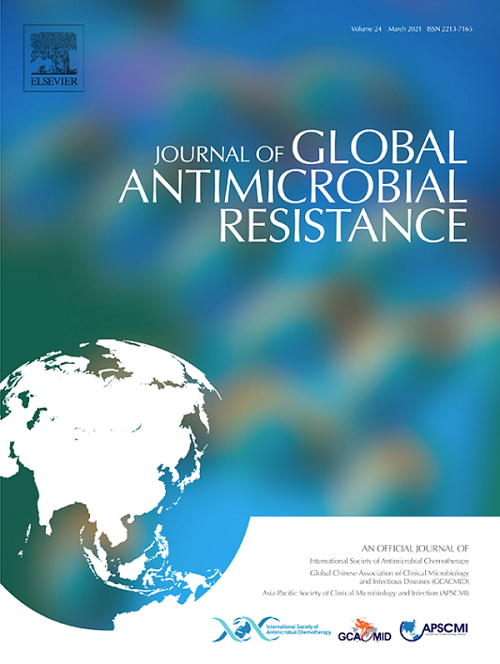ST11 carbapenem-resistant Klebsiella pneumoniae clone harbouring capsular type KL25 becomes the primarily prevalent capsular serotype in a tertiary teaching hospital in China
IF 3.2
3区 医学
Q2 INFECTIOUS DISEASES
引用次数: 0
Abstract
Background
The spread of carbapenem-resistant Klebsiella pneumoniae (CRKP) that produces K. pneumoniae carbapenemase-2 has garnered significant attention due to its increasing prevalence. In China, the dissemination of K. pneumoniae carbapenemase-2-producing CRKP is predominantly linked to sequence type 11 (ST11), with capsular serotypes KL47 and KL64 being the primary capsular identified.
Methods
A total of 64 CRKP-ST11 strains were collected from 2020 to 2023 and whole-genome sequencing was performed on all isolated ST11-CRKP strains. Antibiotic susceptibility was tested using the VITEK 2 system. Growth curve tests and in vitro competition experiments were used to assess the growth adaptability of different capsular type isolates. Moreover, the biofilm assessment and phagocytosis assays were performed to evaluate CRKP isolate virulence.
Results
During the observed period, a notable subclonal shift was perceived within the prevailing ST11-CRKP clone, wherein the previously dominant KL64 and KL47 serotypes have been largely supplanted by the KL25 serotype since 2022. The ST11-KL25-CRKP strain significantly outgrew both ST11-KL64-CRKP and ST11-KL47-CRKP. Additionally, ST11-KL25-CRKP displayed a greater enhanced capacity to form biofilms than ST11-KL64-CRKP and ST11-KL47-CRKP. Furthermore, ST11-KL25-CRKP demonstrated enhanced resistance to phagocytosis than both of its counterparts.
Conclusions
ST11-KL25-CRKP possesses a remarkable level of adaptability and has the potential to regionally replace ST11-KL64-CRKP as the predominant strain in the region. Additionally, this novel and high-risk ST11-KL25-CRKP strain may indicate stronger virulence.
携带荚膜型KL25的ST11耐碳青霉烯肺炎克雷伯菌克隆成为中国某三级教学医院主要流行的荚膜血清型。
目的:耐碳青霉烯肺炎克雷伯菌(CRKP)产生肺炎克雷伯菌碳青霉烯酶-2 (KPC-2)的传播由于其日益流行而引起了广泛关注。在中国,产生kpc -2的CRKP的传播主要与序列11型(ST11)相关,其中荚膜血清型KL47和KL64是主要鉴定的荚膜。方法:2020 - 2023年采集CRKP-ST11菌株64株。我们对所有分离的ST11-CRKP菌株进行了全基因组测序。采用VITEK 2系统检测抗生素敏感性。采用生长曲线试验和体外竞争试验对不同荚膜型菌株的生长适应性进行了评价。此外,采用生物膜评价和吞噬试验对分离株的毒力进行了评价。结果:在观察期间,在普遍存在的ST11-CRKP克隆中没有发现亚克隆转移,其中自2022年以来,先前占主导地位的KL64和KL47血清型已在很大程度上被KL25血清型所取代。ST11-KL25-CRKP明显超过ST11-KL64-CRKP和ST11-KL47-CRKP。此外,ST11-KL25-CRKP比ST11-KL64-CRKP和ST11-KL47-CRKP表现出更强的生物膜形成能力。此外,ST11-KL25-CRKP菌株对吞噬的抵抗力比这两种菌株都强。结论:ST11-KL25-CRKP具有显著的适应性,具有取代ST11-KL64-CRKP成为该地区优势菌株的潜力。新型高风险菌株ST11-KL25-CRKP可能具有更强的毒力。
本文章由计算机程序翻译,如有差异,请以英文原文为准。
求助全文
约1分钟内获得全文
求助全文
来源期刊

Journal of global antimicrobial resistance
INFECTIOUS DISEASES-PHARMACOLOGY & PHARMACY
CiteScore
8.70
自引率
2.20%
发文量
285
审稿时长
34 weeks
期刊介绍:
The Journal of Global Antimicrobial Resistance (JGAR) is a quarterly online journal run by an international Editorial Board that focuses on the global spread of antibiotic-resistant microbes.
JGAR is a dedicated journal for all professionals working in research, health care, the environment and animal infection control, aiming to track the resistance threat worldwide and provides a single voice devoted to antimicrobial resistance (AMR).
Featuring peer-reviewed and up to date research articles, reviews, short notes and hot topics JGAR covers the key topics related to antibacterial, antiviral, antifungal and antiparasitic resistance.
 求助内容:
求助内容: 应助结果提醒方式:
应助结果提醒方式:


